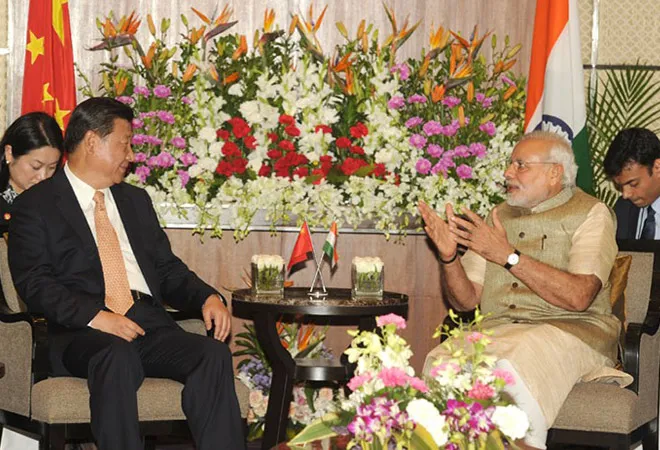For almost two and a half months, Indian and Chinese troops found themselves in a standoff in the Doklam plateau in Bhutan—the worst crisis between the two countries in three decades. That standoff ended on Monday. While both sides seem to have found acceptable face-savers, it is clear that India stands vindicated: the status quo in the Doklam plateau has been restored. Chinese bulldozers have now retreated from the disputed sliver of land (India’s core ask) even though India moved its troops out first (thus meeting a key Chinese demand). What is exceedingly interesting about how the crisis ended was its timing—a week before China hosts the annual BRICS (involving Brazil, Russia, India, China and South Africa) summit in the coastal city of Xiamen.
To be sure, the upcoming meet (which would have, by custom, included a bilateral meeting between Chinese President Xi Jinping and Indian Prime Minister Narendra Modi) is not the sole reason why China agreed to, what in effect is, a climbdown. For example, the local balance of forces and the terrain would have put India ahead of China in any limited military conflict in the Doka La tri-junction area, thus removing Chinese incentives to forcibly dislodge Indian troops. A consequent military debacle would have proved very expensive for Xi ahead of the autumn congress of the Chinese Communist Party.
But at the end, it was Chinese imperative to host a successful summit in Xiamen that may have provided the requisite push to end the face-off in Doklam.
Since becoming president in 2013, Xi has, in his quest to restore China as a central power in the international system, relied on economic and military coercion, and quasi-liberal rhetoric around solidarity with great and small powers alike. From the latter has flowed a new Chinese diplomatic lexicon: of “a new type of great power relations,” “win-win pragmatic cooperation,” and, most recently, “major-country diplomacy with Chinese characteristics”. This rhetoric has sought to couch China’s geopolitical ambitions in benign and acceptable terms. A unifying feature of Chinese diplomatese under Xi has been an emphasis on sovereignty and equity even when Chinese foreign-policy practice has ignored these precepts.
Enter BRICS. Even though the grouping predates Xi’s ascendance to power, he has promoted it as a template for cooperation between emerging powers. As such, BRICS has been a key proof-of-concept that China is willing to play a greater role in global governance—and that it will not remain a perennial shirker in the international system. China’s membership in BRICS has concretely promoted its interests in multiple ways. The BRICS push to reform international financial institutions has led to greater accommodation of China in the International Monetary Fund, for example. BRICS’ nascent norm-making around Westphalian sovereignty and equitability in the international order has been a useful instrument for Beijing to fight the agenda-setting monopoly of Atlantic powers. Above all, BRICS has furthered the cause of a multipolar world—the leading trope in recent Chinese foreign policy—more than any other institution that China has had stakes in.
Western analysts—when not dismissive of the grouping as a glorified talk shop with very little internal coherence—have harboured a nagging suspicion that BRICS seeks to promote an illiberal world order.
A saving grace for the grouping in countering this perception has been India’s membership. Euro-Atlantic powers realize that as a de-facto member of the political West, India’s deep-seated preference for the status quo, its close relationship with the US, and commitment to a liberal global order is what prevents BRICS from becoming an anti-Western coalition led by Russian muscle and Chinese money.
Was Modi to boycott the Xiamen summit, it would have been the end of BRICS as we know it and reduced the grouping to a motley of expansionist powers (Russia and China) and perennial basket cases (Brazil and South Africa). As Xi seeks to fashion himself as the champion of globalization in the era of Donald Trump—witness his Davos speech this January—this would have been terrible press.
Beyond the issue of optics: the Chinese have aggressively pushed for expanding BRICS to include other upcoming economies in the run-up to the Xiamen summit, perhaps as a way to interface a “BRICS Plus” grouping with Xi’s signature Belt and Road Initiative (BRI). Was Modi to skip the summit, this proposition would have been dead on arrival.
If several news reports are to be trusted, New Delhi shrewdly calculated this and accordingly played the boycott card. What added potence to this threat was its credibility: witness how India sat out the Belt and Road Initiative mega-forum earlier this year—the only major country to do so. Beijing would have also been cognizant of how Saarc essentially collapsed when New Delhi refused to participate in the annual summit in Islamabad last year.
At the end of the day, the surprising thing is not that Delhi played this card. It is that Beijing could not foresee this as a distinct possibility when it embarked on a prolonged standoff with India aided by its shrill state-controlled media. Despite China’s braggadocio, through the standoff in Doklam, it has come across as a parvenu in the international system. It has failed to absorb an elementary insight that the very institutions that have facilitated its prominence can be potentially used to constrain its behaviour and shape its choices.
This commentary originally appeared in Live Mint.
The views expressed above belong to the author(s). ORF research and analyses now available on Telegram! Click here to access our curated content — blogs, longforms and interviews.




 PREV
PREV


